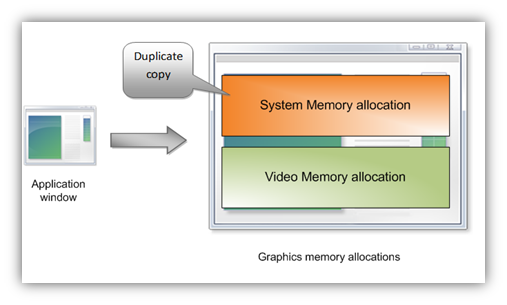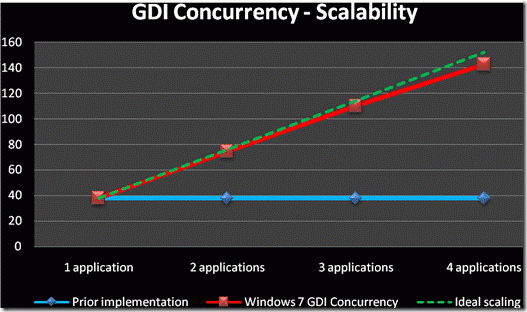2D, Acceleration, And Windows: Aren't All Graphics Cards Equal?
Windows 7: Return Of The Prodigal Son
To many users, Vista earned its bad rep (or perhaps "bad rap") as a memory-hungry monster of an operating system. Nevertheless, it’s worth a second look, in light of the Windows 7 release. We must also observe that Windows 7 is more than just a cleaned up version of Vista, and finally includes many of the functions that one might expect a modern OS to deliver. Along with fundamental changes to the system itself, Windows 7 graphics give back to users what Vista took away—namely, unrestricted 2D graphics acceleration in hardware, including the GDI drawing functions.
Thanks to the introduction of WDDM 1.1, Windows 7 also prevents doubling up on memory usage (once for individual window buffers, and again for each active window in the DWM). This helps facilitate a more slimmed-down system, with more modest resource requirements. In Windows Vista, doubled-up memory consumption explains why system memory became so heavily loaded.
To supplement GDI in Windows 7, Direct2D has also been introduced. This interface uses analog-to-Direct3D conversion to exploit hardware acceleration while also supporting a more complex set of graphics functions. Direct2D enjoys the speed of GDI along with the extended capabilities of the ill-fated GDI+ interface. It still remains to be seen, however, if Direct2D can earn meaningful support from developers.
Even today, the vast majority of programs still use the GDI API for rendering and manipulation of 2D graphics elements. We’re ecstatic that Windows 7 gives back the hardware acceleration for these commands that Vista took away.
Summary:
- Direct forwarding of GDI drawing commands to the graphic drivers via DWM
- Asynchronous and simultaneous processing of GDI commands for multiple windows
- Memory-conserving management strategies for the pending graphics request queue
- New and improved WDDM 1.1 drivers
Graphics Card Vendor Requirement
The return of hardware acceleration for 2D graphics also brings graphics card vendors back into the game. The drivers for Windows 7 must be specially-crafted so they can deliver hardware acceleration for native two-dimensional GDI commands, while also supporting 2.5D layering for individual windows.
Get Tom's Hardware's best news and in-depth reviews, straight to your inbox.
This is a crucial situation for some cards. For example, the current generation of cards from ATI appears to suffer from driver-related difficulties in both of these distinct 2D graphics acceleration areas. You’ll read in the next section about how we detected and what we concluded about these issues.
Current page: Windows 7: Return Of The Prodigal Son
Prev Page Windows Vista: Real Progress And The Art of Omission Next Page Windows 7: Radeon HD 5000-Series Cards Lack 2D AccelerationTom's Hardware is the leading destination for hardcore computer enthusiasts. We cover everything from processors to 3D printers, single-board computers, SSDs and high-end gaming rigs, empowering readers to make the most of the tech they love, keep up on the latest developments and buy the right gear. Our staff has more than 100 years of combined experience covering news, solving tech problems and reviewing components and systems.
-
pcxt21 Very nice work! Until that little update I was ready to put my old Matrox Millennium (1996/1997 I think) 2d accelerator back into my gaming rig...Reply -
For those who still remember Matrox...shouldn't that be included in the test as well? Ancient history shows that it was the best card to be paired with VooDoo when first released...:PReply
-
one-shot LOL. The clip of Steve Ballmer looks like an ad from the late Billy Mays. To think he's the CEO of Microsoft after watching that clip makes me laugh. I'm going to watch it again.Reply -
chookman I actually went to put a Professional Matrox card (G550 PCI-e) in my Windows 7 machinde for a few more displays... alas it seems most of the range doesnt have Windows 7 drivers yet :(Reply -
Belardo The sad thing is, as shown was that Windows 1.0~3.0 were never an operating system, ever. 1.0~2.x we're never really used by anyone, yet Amigas and Macs had full GUI functionality since 85/84... Windows3 was at least usable, but still a single-tasking POS, and yet MS-DOS was able to dominate the computer industry... not because of talent, but because of luck, good moves by Gates & Ballmer and the stupidity of IBM. It kind of worked out anyway thou.Reply
Think about it, it wasn't until the tail-end of 1995, with the release of Windows95, did MS produce an actual GUI OS for the general public, 10 whole years after Apple's Mac and the Amiga by chicken lips. Atari only copied much of the hardware abilities of Amiga with a variant of a MS-DOS clone.
Only business bought PC-Clones in the 80s~90s, paying around $1500~4000 per desktop. Since IBM didn't make the OS and the hardware was generic, it was super easy for clones to exists. Home users bought Amigas and Macs and laughed as DOS users... but in the end, they lost to the clones.
At one time in 1990, the Computer Shopper Mag was about 500 pages (phone book) with at least 500 Clone companies advertising.
Windows is still the Copy-Cat OS. Its still an ugly beast under the hood. At least Windows7 runs good and looks nice.
-
Raid3r Indeed, way to take one for the team..I am one of those 2d workers and greatly appreciate the foot that was used to affirm the position of 2d recognition on these "new" cards. I can't say it enough.Reply -
micky_lund woot for toms...Reply
catch some more massive companies out, and make them fix up their drivers -
Belardo I just finished reading this entire article. A good one too guys.Reply
While I had my rant about old MS days, I did work in the PC field starting with 3.1. We'd benchmark various video cards with programs that would test lines, boxes, etc. This WAS important for some games like DOOM and Quake which were not "true" 3D cards we have today.
For every new type of PC build or a clients computer, I would save these generic overall system benchmarks. And I *have* notice different 2D performance abilities of computers and the various cards. All super fast compared to the 90s, but I've seen a GF card perform worse than an older ATI, but also an older ATI work a bit better than a newer one. These are all WinXP and don't have anything to do with the problems of Win7 and/or DX11... Part2 isn't out yet... but I would be curious to see if the problems in Win7 happens in Vista with DX11 installed hmmm.
ATI has been putting all their work into 3D gaming performance, its good to see that they have put a team to fix their 2D issues. There is a good chance that this is a DX11 issue they were not aware of. Since Nvidia doesn't have any DX11 parts (but a DX10.5) - this "bug" doesn't yet show... but I'm speculating of course. :)
With the eye-candy of Win7, the 2D performance *IS* important for those doing work, watching videos, etc. No good excuse to miss this, and hopefully ATI will have it resolved in 1-2 months.
PS: Your memory usage chart of vista vs Win7 shows exactly WHY Vist . That is why Windows7 runs pretty good on a 1GB computer, but Vista still needs at least 3GB for a bottom-end PC. My notebook has Win7rc with 1GB, runs fine.
Hey, will your results sometime include intel graphics? After this bug-issue is resolves, include overall-2D scores with your graphics Charts. :)





